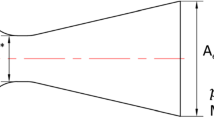Abstract
This paper is concerned with an experimental investigation on plane submerged water jets discharged into quiescent water in an open channel. Flows are visualized by using hydrogen bubbles, solid particles and dye. The results show that the jets attaching to the water surface by the Coanda effect are classified into six types according to their behavior after issuing from the nozzle, and that the self-induced vibration of the jet, which is one of six flow patterns, occurs under the condition of the reduced Froude numberFr *≒0.7∼1.0. An additional analysis of the photographs reveals that the self-induced vibration of the jet is caused by attachment of the jet to the water surface and the ensuing bifurcation of the jet at an attachment point, and that the frequency of vibration is independent of the water level.
Similar content being viewed by others
References
Murao, T. and Sudo, K., Switching Mechanism of a Jet in a Wall-Attachment Device, Trans. of JSME, 56–531, B (1990), 3360–3365.
N. Rajaratnam and K. Subramanya, Hydraulic Jumps Below Abrupt Symmetrical Expansions, Journal of the Hydraulics Division Proceedings of the American Society of Civil Engineers, 94-HY2 (1968), 481–503.
N. Rajaratnam and S. Subramanyan, Plane Turbulent Buoyant Surface Jets and Jumps, Journal of Hydraulic Research, 23–2 (1985), 131–146.
N. S. Govinda Rao and N. Rajaratnam, The Submerged Hydraulic Jump, Journal of the Hydraulics Division Proceedings of the American Society of Civil Engineers, 89-HY1 (1963), 139–163.
Okamoto, K., Madarame, H. and Hagiwara, T., Self-Induced Oscillation of Free Surface in a Tank with Circulating Flow (1st Report, Experimental Results), Trans. of JSME, 57–535, C (1991), 647–653.
Shakouchi, T., Hirai, K., Fujita, K. and Ando, T., Self-Induced Oscillation of Three-Dimensional Turbulent Jet Issued into Open Channel, Trans. of JSME, 62–594, B (1996), 527–532.
Someya, S., Okamoto, K. and Madarae, H., The Self-Induced Free-Surface “Swell Flapping” caused by the interaction among a jet, a free surface and a structure, Journal of Fluids and Structures, 14–4 (2000), 511–528.
Sudo, K., Sumida, M., Hibara, H. and Harada, M., Characteristics of Plane Submerged Water Jets Influenced by Boundaries, Journal of Visualization Society of Japan, 19–72 (1999), 25–33.
Thomas F. Swean Jr., Steven E. Ramberg, Michael W. Plesniak and Michael B. Stewart, Turbulent Surface Jet in Channel of Limited Depth, The Journal of Hydraulic Engineering, 115–12 (1989), 1587–1606.
Author information
Authors and Affiliations
Corresponding author
Additional information
Shimada Nobukazu: He received the M.Sc (Mercantile Marine) degree in 1983 from Tokyo University of Mercantile Marine. After obtaining the M.Sc. degree he became a lecturer at the Japan Coast Guard Academy. Then he went on to Hiroshima University to study, and received the D.Eng. degree in 2001 from the same university. Currently he works as a professor at J.C.G.A. His research interests include the flow visualization and self-induced vibration phenomenon of submerged water jets.
Hibara Hideki: He obtained the M.Eng. degree in 1990 from Hiroshima University. Since then, serving as a research associate, he has worked on the interaction between jets and boundary surfaces, and received the D.Eng. degree in 1998 from Hiroshima University. Currently he is working as an associate professor at Ehime University. His research interests include the control of jets and the flow structures in various pipe flows.
Ishibashi Yukio: He received the D.Eng. degree in 1989 from the Science University of Tokyo. He devoted himself to the study of fluid dynamics at the Tokyo Institute of Technology from 1969 to 1991. He moved to Chiba Polytechnic College as an associate professor in 1991 and works now as a professor. He has academic achievements in the areas of electromagnetic and ferromagnetic fluid dynamics, in addition to jet dynamics.
Sumida Masaru: He received the M.Eng. degree from the Tokyo Institute of Technology in 1977. He received the D.Eng. degree in Mechanical Engineering in 1990 from Hiroshima University. He has worked in the Department of Mechanical System Engineering, Hiroshima University, since 1996. His research interests include the flow visualization and unsteady (oscillating and pulsating) flows in pipes and ducts.
Sudo Kozo: He received the M.Eng. degree in 1964 and the D.Eng. degree in 1975 from the Tokyo Institute of Technology. He worked as a research associate at the Tokyo Institute of Technology from 1968 to 1980, and moved to Hiroshima University as an associate professor in 1980. He is now a professor emeritus of Hiroshima University and works as a professor at the Shibaura Institute of Technology.
Rights and permissions
About this article
Cite this article
Shimada, N., Hibara, H., Ishibashi, Y. et al. Analysis of submerged water jets by visualization method. J Vis 7, 281–289 (2004). https://doi.org/10.1007/BF03181532
Received:
Revised:
Issue Date:
DOI: https://doi.org/10.1007/BF03181532




